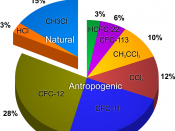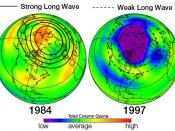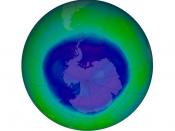The Ozone Layer: What does it do and what happens when it is depleted?
The ozone layer is one of the most debated scientific subjects of the last decade. The growing problem of its depletion is being researched heavily all over the world, and methods are being researched to try and solve the problem. There have also been many debates concerning the relationship between the ozone layer and the onset of global warming. Before solutions can be developed, however, what the ozone layer actually does and what is causing it to be depleted must be understood.
The ozone layer is a section in Earth's stratosphere that sits between ten and fifty miles above the surface. The ozone layer is a protective barrier that exists between the life forms on Earth and absorbs the harmful ultraviolet-B raditation from the sun. This protective layer is essential in order for life to exist on the Earth.
Ozone is a colorless gas that is formed by a chemical reaction of oxygen molecules, oxygen atoms, and solar radiation. Contrary to popular belief, ozone is actually a greenhouse gas and the loss of it would actually decrease the global warming effect on Earth instead of increasing it (Introduction). Ozone in the stratosphere is beneficial to life on Earth, but ozone at ground level is harmful to living things. Ozone on the ground level is made by sunlight reacting with motor vehicle exhaust gases and is a major component of smog in major cities. (Green Lane).
In recent years, a large hole in the ozone layer has begun to develop over Antarctica during the spring season, and a smaller hole has been found over the North Pole as well. A reduction in the ozone layer over the mid-latitudes has also been found, and the ozone layer over...


